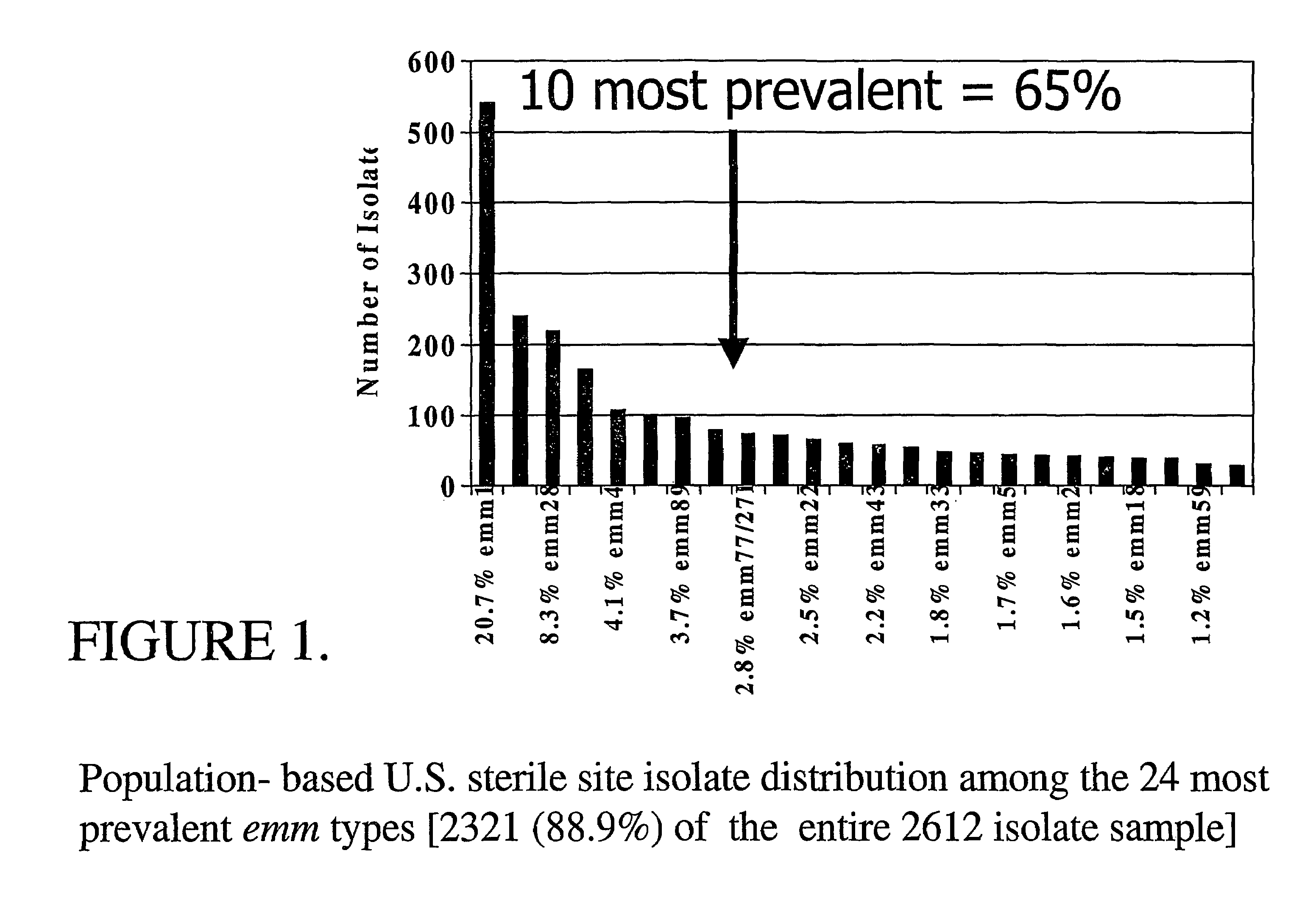Peptide vaccines against group A streptococci
a technology of streptococci and peptides, applied in the field of immunomodulatory molecules and compositions, can solve problems such as rheumatic fever acu
- Summary
- Abstract
- Description
- Claims
- Application Information
AI Technical Summary
Problems solved by technology
Method used
Image
Examples
example 1
Peptide Recognition by Anti M-protein Rabbit Sera
[0080]The immunoreactivity of several synthetic peptides was determined by ELISA using rabbit sera prepared against whole M protein. The synthetic peptides are representative of relatively small portions of the M protein N-terminus; therefore, it was advantageous to determine if the epitopes contained within particular peptides were immunoreactive with sera prepared against whole M protein. It was shown that the whole anti-M protein rabbit sera of the respective serotypes could bind to each of the synthetic peptides within that serotype. However, some peptides were more highly immunoreactive than others, thus being better suited for use in the animal studies. The peptides showing the highest reactivity in each serotype group tested were M1-4, M3-2 and M12-1. This indicated that immunoreactive epitopes were contained within the amino acid sequences of the synthetic peptides.
[0081]The immunoreactivity of peptides with SEQ ID NO:1, SEQ I...
example 2
Immunogenicity of Synthetic Peptides in Swiss Webster Mice
[0082]Studies were then carried out in vivo in a mouse model to determine the ability of the tested synthetic peptides to protect against GAS challenge and to evaluate their immunogenicity as a single MAP formulation.
[0083]Mice were immunized s.c. with selected peptides using aluminum hydroxide or aluminum phosphate as an adjuvant. Serology results indicated that aluminum hydroxide elicited higher antibody levels and, therefore, it was used for all subsequent immunizations. ELISA indicated that antibodies were elicited to the M type peptides.
[0084]
TABLE 2ELISA results determining elicitation of antibodies.PeptideELISAM1-4noM1-2noM1-3yesM3-1yesM3-2yesM3-4noM12-1yesM12-2yes (weak)M12-3no
[0085]Five of the nine synthetic peptides shown in Table 2 were able to elicit an antibody response, with each of the three serotypes under investigation being represented by at least one immunogenic peptide. The titers of the immunogenic peptid...
example 3
Opsonophagocytosis
[0089]The mouse sera that were shown to contain anti-M antibodies by the ELISA assay were then tested for functional activity with the in vitro opsonophagocytosis assay (Lancefield 1959), Table 4. Each of the sera tested positive in the assay and was able to reduce the amount of viable bacteria relative to controls. The values for the reduction of bacteria in the opsonophagocytosis assays were as shown in Table 5.
[0090]
TABLE 4Sera results for opsonophagocytosis assay.PeptideOpsono (in vitro)M1-4ndM1-2ndM1-3yesM3-1yesM3-2yesM3-4ndM12-1yesM12-2ndM12-3nd
[0091]
TABLE 5Percentage reduction of viable GAS bacteria.PeptideReductionM1-3 50%M3-180-90%M3-260-80%M12-170-80%
It is interesting to note that within the M3 serotype, while the M3-1 peptide induced an antibody response that was more than a magnitude lower than that of the M3-2 peptide, it was able to opsonophagocytize bacteria more effectively.
[0092]Mouse sera is tested that is shown to contain anti-M antibodies from ...
PUM
| Property | Measurement | Unit |
|---|---|---|
| pH | aaaaa | aaaaa |
| composition | aaaaa | aaaaa |
| conjugated structure | aaaaa | aaaaa |
Abstract
Description
Claims
Application Information
 Login to View More
Login to View More - R&D
- Intellectual Property
- Life Sciences
- Materials
- Tech Scout
- Unparalleled Data Quality
- Higher Quality Content
- 60% Fewer Hallucinations
Browse by: Latest US Patents, China's latest patents, Technical Efficacy Thesaurus, Application Domain, Technology Topic, Popular Technical Reports.
© 2025 PatSnap. All rights reserved.Legal|Privacy policy|Modern Slavery Act Transparency Statement|Sitemap|About US| Contact US: help@patsnap.com

